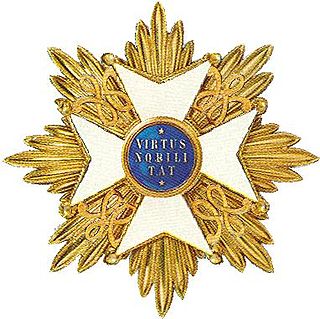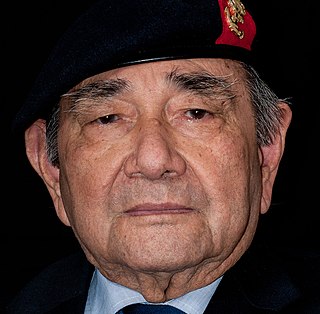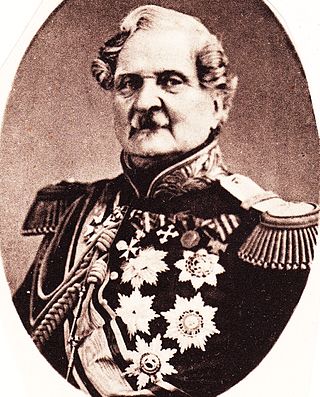
Etienne Henri "Hans" Larive, MWO, DSC and bar, was a Dutch naval officer during World War II. He escaped from the prisoner of war camp Oflag IV-C at Colditz Castle in 1941, and spent the rest of the war in England serving aboard Motor Torpedo Boats. He later wrote his memoir Vannacht varen de Hollanders (1950), which was republished translated into English as The Man Who Came in From Colditz (1975) – a pun on the best-selling novel The Spy Who Came in from the Cold.

The Netherlands Marine Corps is the elite naval infantry corps of the Royal Netherlands Navy, one of the four Armed Forces of the Kingdom of the Netherlands. The marines trace their origins to the establishment of the Regiment de Marine on 10 December 1665, by the then grand pensionary of the Dutch Republic, Johan de Witt and famous Admiral Michiel de Ruyter. It is the second-oldest still-active marine corps in the world.

The Military William Order, or often named Military Order of William, is the oldest and highest honour of the Kingdom of the Netherlands. It is named after St. William of Gellone (755–814), the first Prince of Orange. Its motto is Voor Moed, Beleid en Trouw. The chivalric order was established on 30 April 1815 by King William I and was presented for feats of excellent bravery on the battlefield and as a meritorious decoration to senior military officers. Comparable with the French Légion d’Honneur but far less often awarded, it is open to everyone regardless of rank or nobility—not only to Dutch military, but also to foreigners. To date, membership in the Order is extremely rarely awarded, and only for exceptional bravery in battle.

The Royal Netherlands Army is the land branch of the Netherlands Armed Forces. Though the Royal Netherlands Army was raised on 9 January 1814, its origins date back to 1572, when the Staatse Leger was raised making the Dutch standing army one of the oldest in the world. It fought in the Napoleonic Wars, World War II, the Indonesian War of Independence, and the Korean War, and served with NATO on the Cold War frontiers in West Germany from the 1950s to the 1990s.

The Royal Netherlands East Indies Army was the military force maintained by the Kingdom of the Netherlands in its colony of the Dutch East Indies, in areas that are now part of Indonesia. The KNIL's air arm was the Royal Netherlands East Indies Army Air Force. Elements of the Royal Netherlands Navy and Government Navy were also stationed in the Netherlands East Indies.
The Military ranks of the Netherlands armed forces are the military insignia used by the armed forces of the Netherlands.

Task Force Uruzgan (TFU) was Australia's and the Netherlands' contribution to NATO's Regional Command South, International Security Assistance Force, in Afghanistan. The Dutch led one of the four Provincial Reconstruction Teams in the southern region of the country. Mandated by the Dutch Parliament in February 2006, between 1,200 to 1,400 Dutch military were tasked to maintain order in Uruzgan Province through July 2010. They were also to develop political and economic infrastructure and to train the Afghan National Police.

Korps Speciale Troepen was a Royal Netherlands East Indies Army (KNIL) special forces unit that was established for deployment against the Indonesian revolutionaries during the Indonesian National Revolution. It was formed in 1948 with the Depot Speciale Troepen at its core and disbanded alongside the Royal Netherlands East Indies Army in 1950, by which time it had been renamed to the Regiment Speciale Troepen. The DST consisted of about 570 men at its establishment in 1945 and had a precursor in the Korps Insulinde that conducted clandestine operations during the Japanese occupation of the Dutch East Indies. In June 1949, 250 men of the 1st Parachute Company were integrated into the Corps. The KST, which would reach a maximum strength of 1250 men, was composed of Dutch war volunteers (OVWs), Eurasians and native soldiers, including Moluccans. The present day Korps Commandotroepen of the Royal Netherlands Army is considered a continuation of the RST.

In the Dutch honours system, most orders are the responsibility of ministers of the Netherlands Government. The house orders, however, are awarded at the discretion of the Dutch monarch alone.

Prince Carl Bernhard of Saxe-Weimar-Eisenach was a distinguished soldier, who, in 1815, after the congress of Vienna, became colonel of a regiment in the service of the king of the Netherlands. He fought at the Battle of Quatre Bras and the Battle of Waterloo where he commanded the 2nd Brigade of the 2nd Dutch Division, and later became a Chief Commander of the Royal Netherlands East Indies Army.

Petrus Johannes Mathias "Peter" van Uhm is a retired Royal Netherlands Army general. He served as Chief of Defence of the Armed forces of the Netherlands from 17 April 2008 until 28 June 2012. He previously served as the Commander of the Royal Netherlands Army from 5 September 2005 until 13 March 2008.

The 11 Air Assault Brigade is the rapid light infantry brigade of the Royal Netherlands Army, focused on conducting air assault operations. Troops of the brigade are qualified to wear the maroon beret upon completion of the demanding training course, those qualified as military parachutists wear the appropriate parachutist wings. The brigade received the name "7 December" when the First Division "7 December" was disbanded in 2004.

Bersiap is the name given by the Dutch to a violent and chaotic phase of the Indonesian National Revolution following the end of World War II. The Indonesian word bersiap means 'get ready' or 'be prepared'. The Bersiap period lasted from August 1945 to November 1947. In Indonesia, other terms aside from bersiap are commonly used, such as gedoran in Depok, ngeli in Banten and surrounding West Java, and gegeran and dombreng in Central Java.

Giovanni Narcissus Hakkenberg was a Dutch marine of Indonesian and European descent, and decorated war hero and knight of the Military Order of William. The Military William Order is the highest honour in the Netherlands, bestowed for "performing excellent acts of Bravery, Leadership and Loyalty in battle".

The Korps Commandotroepen (KCT) is the elite special forces unit of the Royal Netherlands Army. The KCT traces its origins to the Second World War with the founding of No. 2 (Dutch) Troop, and the founding of the Korps Speciale Troepen during the Indonesian War of Independence. At present, the unit is tasked with conducting the full spectrum of special operations, its principal tasks being direct action, special reconnaissance, military assistance and counter-terrorism.

Major Kenneth George Mayhew was a British Army veteran of the Second World War. Mayhew was one of the recipients of the Military William Order, the highest honour of the Kingdom of the Netherlands.

Jacobus Smede "Koos" Sinninghe Damsté (1902–1995) was a lawyer in colonial Indonesia during 1927–1942, prosecutor of Japanese war criminals during 1946–1947, chairman of the national business association in Indonesia during 1948–1954, and head of the Netherlands Security Service during 1955–1967.
Korps Insulinde was a Dutch special forces unit established in March 1942 in British Ceylon, present-day Sri Lanka. The unit, originally called the Netherland Special Operations, emerged from the Princess Irene Brigade alongside No. 2 (Dutch) Troop of the No. 10 (Inter-Allied) Commando. The Korps Insulinde fought during World War II against the Japanese occupiers of the Dutch East Indies. The corps was commanded by Major Frits Mollinger of the Royal Netherlands East Indies Army (KNIL) and was stationed in Ceylon. It carried out a number of infiltration and intelligence operations in occupied Sumatra. The corps was disbanded between November 1945 and early March 1946.

In order to contain the violence in the Dutch East Indies after the Japanese capitulation in 1945 and to restore colonial order, the Netherlands sent battalions of Oorlogsvrijwilligers to the colony. They were recruited in 1944 and 1945, mostly in the southern provinces of the Netherlands, and initially intended for deployment in Europe. Others had signed up for the fight against Japan in the summer of 1945.

François Vincent Henri Antoine de Stuers was a Dutch general, commander of the Indies army.




















